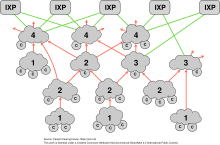Internet transit
This article needs additional citations for verification. (July 2020) |
Internet transit is the service of allowing network traffic to cross or "transit" a computer network, usually used to connect a smaller Internet service provider (ISP) to the larger Internet. Technically, it consists of two bundled services:
- The advertisement of customer routes to other ISPs, thereby soliciting inbound traffic toward the customer from them
- The advertisement of other ISPs' routes (usually but not necessarily in the form of a default route or a full set of routes to all of the destinations on the Internet) to the ISP's customer, thereby soliciting outbound traffic from the customer towards these networks.

In the 1970s and early 1980s-era Internet, the assumption was made that all networks would provide full transit for one another. In the modern private-sector Internet, two forms of
Pricing for the internet transit varies at different times and geographical locations.
See also
- Commercial Internet eXchange (CIX)
- Federal Internet Exchange (FIX)
- Internet exchange point (IXP)
References
- ^ "Tiers of Internet service providers - Tier 1, Tier 2, Tier 3". 12 November 2020.
- ISBN 978-1-84542-675-0.
- S2CID 64300837.
- ^ "The Relative Cost of Bandwidth Around the World" (PDF). www.accc.gov.au.
